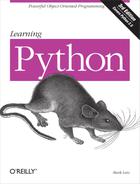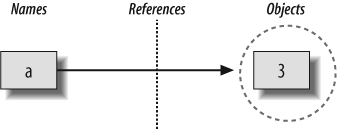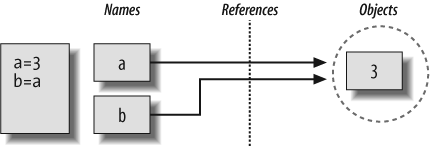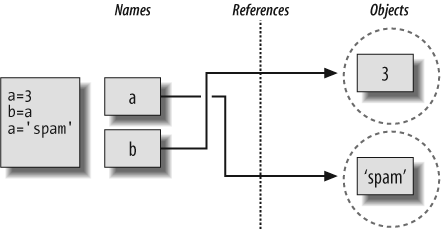Chapter 6. The Dynamic Typing Interlude
In the prior chapter, we began exploring Python’s core object types in depth with a look at Python numbers. We’ll resume our object type tour in the next chapter, but before we move on, it’s important that you get a handle on what may be the most fundamental idea in Python programming, and is certainly the basis of much of both the conciseness and flexibility of the Python language—dynamic typing, and the polymorphism it yields.
As you’ll see here and later in the book, in Python, we do not declare the specific types of the objects our scripts use. In fact, programs should not even care about specific types; in exchange, they are naturally applicable in more contexts than we can sometimes even plan ahead for. Because dynamic typing is the root of this flexibility, let’s take a brief look at the model here.
The Case of the Missing Declaration Statements
If you have a background in compiled or statically typed languages like C, C++, or Java, you might find yourself a bit perplexed at this point in the book. So far, we’ve been using variables without declaring their existence or their types, and it somehow works. When we type a = 3 in an interactive session or program file, for instance, how does Python know that a should stand for an integer? For that matter, how does Python know what a is at all?
Once you start asking such questions, you’ve crossed over into the domain of Python’s dynamic typing model. In Python, types are determined automatically at runtime, not in response to declarations in your code. This means that you never declare variables ahead of time (a concept that is perhaps simpler to grasp if you keep in mind that it all boils down to variables, objects, and the links between them).
Variables, Objects, and References
As you’ve seen in many of the examples used so far in this book, when you run an assignment statement such as a = 3 in Python, it works even if you’ve never told Python to use the name a as a variable, or that a should stand for an integer-type object. In the Python language, this all pans out in a very natural way, as follows:
- Variable creation
A variable (i.e., name), like
a, is created when your code first assigns it a value. Future assignments change the value of the already created name. Technically, Python detects some names before your code runs, but you can think of it as though initial assignments make variables.- Variable types
A variable never has any type information or constraints associated with it. The notion of type lives with objects, not names. Variables are generic in nature; they always simply refer to a particular object at a particular point in time.
- Variable use
When a variable appears in an expression, it is immediately replaced with the object that it currently refers to, whatever that may be. Further, all variables must be explicitly assigned before they can be used; use of unassigned variables results in errors.
This model is strikingly different from traditional languages. When you are first starting out, dynamic typing is usually easier to understand if you keep clear the distinction between names and objects. For example, when we say this:
>>>
a = 3
at least conceptually, Python will perform three distinct steps to carry out the request. These steps reflect the operation of all assignments in the Python language:
Create an object to represent the value
3.Create the variable
a, if it does not yet exist.Link the variable
ato the new object3.
The net result will be a structure inside Python that resembles Figure 6-1. As sketched, variables and objects are stored in different parts of memory, and are associated by links (the link is shown as a pointer in the figure). Variables always link to objects, and never to other variables, but larger objects may link to other objects (for instance, a list object has links to the objects it contains).
These links from variables to objects are called references in Python—that is, a reference is a kind of association, implemented as a pointer in memory.[16] Whenever the variables are later used (i.e., referenced), Python automatically follows the variable-to-object links. This is all simpler than the terminology may imply. In concrete terms:
Variables are entries in a system table, with spaces for links to objects.
Objects are pieces of allocated memory, with enough space to represent the values for which they stand.
References are automatically followed pointers from variables to objects.
At least conceptually, each time you generate a new value in your script by running an expression, Python creates a new object (i.e., a chunk of memory) to represent that value. Internally, as an optimization, Python caches and reuses certain kinds of unchangeable objects, such as small integers and strings (each 0 is not really a new piece of memory—more on this caching behavior later). But, from a logical perspective, it works as though each expression’s result value is a distinct object, and each object is a distinct piece of memory.
Technically speaking, objects have more structure than just enough space to represent their values. Each object also has two standard header fields: a type designator used to mark the type of the object, and a reference counter used to determine when it’s OK to reclaim the object. To understand how these two header fields factor into the model, we need to move on.
Types Live with Objects, Not Variables
To see how object types come into play, watch what happens if we assign a variable multiple times:
>>>
a = 3# It's an integer >>>a = 'spam'# Now it's a string >>>a = 1.23# Now it's a floating point
This isn’t typical Python code, but it does work—a starts out as an integer, then becomes a string, and finally becomes a floating-point number. This example tends to look especially odd to ex-C programmers, as it appears as though the type of a changes from integer to string when we say a = 'spam'.
However, that’s not really what’s happening. In Python, things work more simply: names have no types; as stated earlier, types live with objects, not names. In the preceding listing, we’ve simply changed a to reference different objects. Because variables have no type, we haven’t actually changed the type of the variable a—we’ve simply made the variable reference a different type of object. In fact, again, all we can ever say about a variable in Python is that it references a particular object at a particular point in time.
Objects, on the other hand, know what type they are—each object contains a header field that tags the object with its type. The integer object 3, for example, will contain the value 3, plus a designator that tells Python that the object is an integer (strictly speaking, a pointer to an object called int, the name of the integer type). The type designator of the 'spam' string object points to the string type (called str) instead. Because objects know their types, variables don’t have to.
To recap, types are associated with objects in Python, not with variables. In typical code, a given variable usually will reference just one kind of object. Because this isn’t a requirement, though, you’ll find that Python code tends to be much more flexible than you may be accustomed to—if you use Python well, your code might work on many types automatically.
I mentioned that objects have two header fields, a type designator and a reference counter. To understand the latter of these, we need to move on, and take a brief look at what happens at the end of an object’s life.
Objects Are Garbage-Collected
In the prior section’s listings, we assigned the variable a to different types of objects in each assignment. But when we reassign a variable, what happens to the value it was previously referencing? For example, after the following statements, what happens to the object 3?
>>>
a = 3>>>a = 'spam'
The answer is that in Python, whenever a name is assigned to a new object, the space held by the prior object is reclaimed (if it is not referenced by any other name or object). This automatic reclamation of objects’ space is known as garbage collection.
To illustrate, consider the following example, which sets the name x to a different object on each assignment:
>>>
x = 42>>>x = 'shrubbery'# Reclaim 42 now (unless referenced elsewhere) >>>x = 3.1415# Reclaim 'shrubbery' now >>>x = [1, 2, 3]# Reclaim 3.1415 now
First, notice that x is set to a different type of object each time. Again, though this is not really the case, the effect is as though the type of x is changing over time. In Python, types live with objects, not names. Because names are just generic references to objects, this sort of code works naturally.
Second, notice that references to objects are discarded along the way. Each time x is assigned to a new object, Python reclaims the prior object’s space. For instance, when it is assigned the string 'shrubbery', the object 42 is immediately reclaimed (assuming it is not referenced anywhere else)—the object’s space is automatically thrown back into the free space pool, to be reused for a future object.
Internally, Python accomplishes this feat by keeping a counter in every object that keeps track of the number of references currently pointing to that object. As soon as (and exactly when) this counter drops to zero, the object’s memory space is automatically reclaimed. In the preceding listing, we’re assuming that each time x is assigned to a new object, the prior object’s reference counter drops to zero, causing it to be reclaimed.
The most immediately tangible benefit of garbage collection is that it means you can use objects liberally without ever needing to free up space in your script. Python will clean up unused space for you as your program runs. In practice, this eliminates a substantial amount of bookkeeping code compared to lower-level languages such as C and C++.
Shared References
So far, we’ve seen what happens as a single variable is assigned references to objects. Now, let’s introduce another variable into our interaction, and watch what happens to its names and objects:
>>>
a = 3>>>b = a
Typing these two statements generates the scene captured in Figure 6-2. As before, the second line causes Python to create the variable b; the variable a is being used and not assigned here, so it is replaced with the object it references (3), and b is made to reference that object. The net effect is that variables a and b wind up referencing the same object (that is, pointing to the same chunk of memory). This is called a shared reference in Python—multiple names referencing the same object.
Next, suppose we extend the session with one more statement:
>>>
a = 3>>>b = a>>>a = 'spam'
As for all Python assignments, this statement simply makes a new object to represent the string value 'spam' and sets a to reference this new object. It does not, however, change the value of b; b still references the original object, the integer 3. The resulting reference structure is shown in Figure 6-3.
The same sort of thing would happen if we changed b to 'spam' instead—the assignment would change only b, not a. This behavior also occurs if there are no type differences at all. For example, consider these three statements:
>>>
a = 3>>>b = a>>>a = a + 2
In this sequence, the same events transpire: Python makes the variable a reference the object 3, and makes b reference the same object as a, as in Figure 6-2; as before, the last assignment then sets a to a completely different object (in this case, the integer 5, which is the result of the + expression). It does not change b as a side effect. In fact, there is no way to ever overwrite the value of the object 3—as introduced in Chapter 4, integers are immutable, and thus can never be changed in-place.
One way to think of this is that, unlike in some languages, in Python, variables are always pointers to objects, not labels of changeable memory areas: setting a variable to a new value does not alter the original object, but rather causes the variable to reference an entirely different object. The net effect is that assignment to a variable can impact only the single variable being assigned. When mutable objects and in-place changes enter the equation, though, the picture changes somewhat; to see how, let’s move on.
Shared References and In-Place Changes
As you’ll see later in this part’s chapters, there are objects and operations that perform in-place object changes. For instance, an assignment to an offset in a list actually changes the list object itself in-place, rather than generating a brand new list object. For objects that support such in-place changes, you need to be more aware of shared references, since a change from one name may impact others.
To further illustrate, let’s take another look at the list objects introduced in Chapter 4. Recall that lists, which do support in-place assignments to positions, are simply collections of other objects, coded in square brackets:
>>>
L1 = [2, 3, 4]>>>L2 = L1
L1 here is a list containing the objects 2, 3, and 4. Items inside a list are accessed by their positions, so L1[0] refers to object 2, the first item in the list L1. Of course, lists are also objects in their own right, just like integers and strings. After running the two prior assignments, L1 and L2 reference the same object, just like a and b in the prior example (see Figure 6-2). Also, as before, if we now extend this interaction to say the following:
>>>
L1 = 24
L1 is simply set to a different object; L2 still references the original list. If we change this statement’s syntax slightly, however, it has radically different effect:
>>>
L1 = [2, 3, 4]# A mutable object >>>L2 = L1# Make a reference to the same object >>>L1[0] = 24# An in-place change >>>L1# L1 is different [24, 3, 4] >>>L2# But so is L2! [24, 3, 4]
Here, we haven’t changed L1 itself; we’ve changed a component of the object that L1 references. This sort of change overwrites part of the list object in-place. Because the list object is shared by (referenced from) other variables, though, an in-place change like this doesn’t only affect L1—that is, you must be aware that when you make such changes, they can impact other parts of your program. In this example, the effect shows up in L2 as well because it references the same object as L1. Again, we haven’t actually changed L2, but its value will appear different.
This behavior is usually what you want, but you should be aware of how it works, so that it’s expected. It’s also just the default: if you don’t want such behavior, you can request that Python copy objects, instead of making references. There are a variety of ways to copy a list, including the built-in list function, and the standard library copy module. Perhaps the most common way is to slice from start to finish (see Chapter 4 and Chapter 7 for more on slicing):
>>>
L1 = [2, 3, 4]>>>L2 = L1[:]# Make a copy of L1 >>>L1[0] = 24>>>L1[24, 3, 4] >>>L2# L2 is not changed [2, 3, 4]
Here, the change made through L1 is not reflected in L2 because L2 references a copy of the object L1 references; that is, the two variables point to different pieces of memory.
Note that this slicing technique won’t work on the other mutable core type, dictionaries, because they are not sequences—to copy a dictionary, instead use the D.copy( ) method. Also, note that the standard library copy module has a call for copying any object type generically, as well as a call for copying nested object structures (a dictionary with nested lists, for example):
import copy X = copy.copy(Y) # Make a top-level "shallow" copy of any object Y X = copy.deepcopy(Y) # Make a deep copy of any object Y: copy all nested parts
We’ll explore lists and dictionaries in more depth, and revisit the concept of shared references and copies, in Chapter 8 and Chapter 9. For now, keep in mind that objects that can be changed in-place (that is, mutable objects) are always open to these kinds of effects. In Python, this includes lists, dictionaries, and some objects defined with class statements. If this is not the desired behavior, you can simply copy your objects as needed.
Shared References and Equality
In the interest of full disclosure, I should point out that the garbage-collection behavior described earlier in this chapter may be more conceptual than literal for certain types. Consider these statements:
>>>
x = 42>>>x = 'shrubbery'# Reclaim 42 now?
Because Python caches and reuses small integers and small strings, as mentioned earlier, the object 42 here is probably not literally reclaimed; instead, it will likely remain in a system table to be reused the next time you generate a 42 in your code. Most kinds of objects, though, are reclaimed immediately when no longer referenced; for those that are not, the caching mechanism is irrelevant to your code.
For instance, because of Python’s reference model, there are two different ways to check for equality in a Python program. Let’s create a shared reference to demonstrate:
>>>
L = [1, 2, 3]>>>M = L# M and L reference the same object >>>L == M# Same value True >>>L is M# Same object True
The first technique here, the == operator, tests whether the two referenced objects have the same values; this is the method almost always used for equality checks in Python. The second method, the is operator, instead tests for object identity—it returns True only if both names point to the exact same object, and so is a much stronger form of equality testing.
Really, is simply compares the pointers that implement references, and is a way to detect shared references in your code if needed. It returns False if the names point to equivalent but different objects, as is the case when we run two different literal expressions:
>>>
L = [1, 2, 3]>>>M = [1, 2, 3]# M and L reference different objects >>>L == M# Same values True >>>L is M# Different objects False
Watch what happens when we perform the same operations on small numbers:
>>>
X = 42>>>Y = 42# Should be two different objects >>>X == YTrue >>>X is Y# Same object anyhow: caching at work! True
In this interaction, X and Y should be == (same value), but not is (same object) because we ran two different literal expressions. Because small integers and strings are cached and reused, though, is tells us they reference the same single object.
In fact, if you really want a look under the hood, you can always ask Python how many references there are to an object: the getrefcount function in the standard sys module returns the object’s reference count. When I ask about the integer object 1 in the IDLE GUI, for instance, it reports 837 reuses of this same object (most of which are in IDLE’s system code, not mine):
>>>
import sys>>>sys.getrefcount(1)# 837 pointers to this shared piece of memory 837
This object caching and reuse is irrelevant to your code (unless you run the is check!). Because you cannot change numbers or strings in-place, it doesn’t matter how many references there are to the same object. Still, this behavior reflects one of many ways Python optimizes its model for execution speed.
Dynamic Typing Is Everywhere
You don’t really need to draw name/object diagrams with circles and arrows to use Python. When you’re starting out, though, it sometimes helps you understand unusual cases if you can trace their reference structures. If a mutable object changes out from under you when passed around your program, for example, chances are you are witnessing some of this chapter’s subject matter firsthand.
Moreover, even if dynamic typing seems a little abstract at this point, you probably will care about it eventually. Because everything seems to work by assignment and references in Python, a basic understanding of this model is useful in many different contexts. As you’ll see, it works the same in assignment statements, function arguments, for loop variables, module imports, and more. The good news is that there is just one assignment model in Python; once you get a handle on dynamic typing, you’ll find that it works the same everywhere in the language.
At the most practical level, dynamic typing means there is less code for you to write. Just as importantly, though, dynamic typing is also the root of polymorphism—a concept we introduced in Chapter 4, and will revisit again later in this book—in Python. Because we do not constrain types in Python code, it is highly flexible. As you’ll see, when used right, dynamic typing and the polymorphism it provides produce code that automatically adapts to new requirements as your systems evolve.
Chapter Summary
This chapter took a deeper look at Python’s dynamic typing model—that is, the way that Python keeps track of object types for us automatically, rather than requiring us to code declaration statements in our scripts. Along the way, we learned how variables and objects are associated by references in Python; we also explored the idea of garbage collection, learned how shared references to objects can affect multiple variables, and saw how references impact the notion of equality in Python.
Because there is just one assignment model in Python, and because assignment pops up everywhere in the language, it’s important that you have a handle on the model before moving on. The chapter quiz coming up should help you review some of this chapter’s ideas. After that, we’ll resume our object tour in the next chapter, with strings.
BRAIN BUILDER
[16] * Readers with a background in C may find Python references similar to C pointers (memory addresses). In fact, references are implemented as pointers, and they often serve the same roles, especially with objects that can be changed in-place (more on this later). However, because references are always automatically dereferenced when used, you can never actually do anything useful with a reference itself; this is a feature that eliminates a vast category of C bugs. You can think of Python references as C “void*” pointers, which are automatically followed whenever used.



